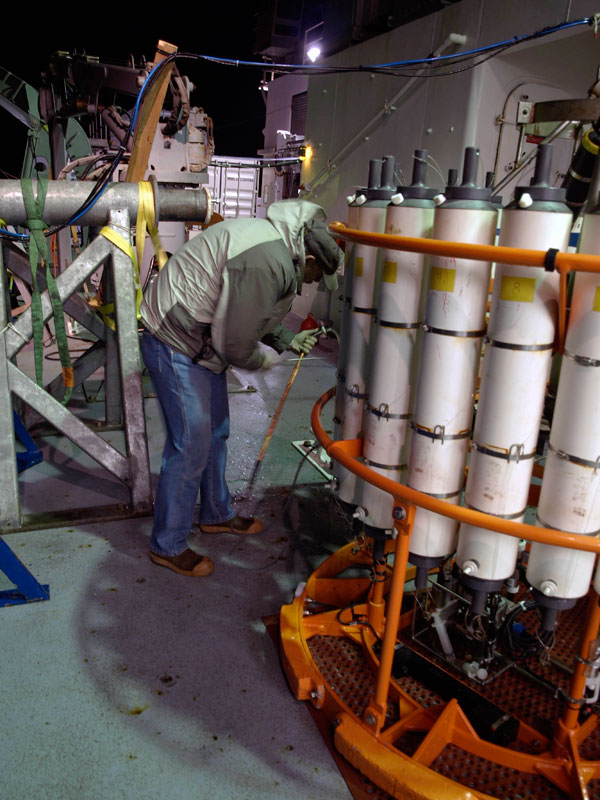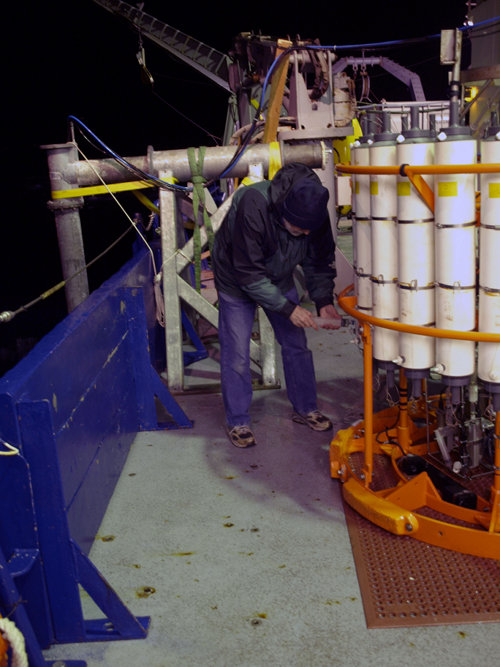
By Chris German, Woods Hole Oceanographic Institution
April 24, 2012

Ron at the rosette collecting samples for helium isotope analysis. Ron and our shore-based co-principal investigator, John Lupton, will be analyzing these samples back in the NOAA-Pacific Marine Environmental Laboratory lab in Oregon using the same techniques John helped pioneer for hydrothermal research dating back to the 1970s. Image courtesy of Chris German, INSPIRE: Chile Margin 2012 Expedition, NOAA-OER. Download larger version (jpg, 2.3 MB).
Throughout the 25 years I have been going to sea, an instrument I always rely on is the CTD-rosette system we use for collecting water samples from different depths in the ocean.
The “CTD” part stands for Conductivity-Temperature-Depth (the three key things that are measured). The temperature and depth are probably self-explanatory, but we also measure conductivity, so that we can then calculate the total salinity (crudely, how salty the sea is). All three parameters are measured in real time as we lower the instrument toward the seabed and are reported back to our watch keepers, who monitor the data read outs in the main lab.
From that computer control, we can also collect bottles of water that we bring back aboard ship for chemical analysis from a set of 24 bottles arranged in a circular pattern around the sensor package – hence the name rosette. Each bottle is actually a hollow cylinder that can hold 10 liters of seawater with caps at either end that are held open under tension. While the caps are open, water can flow through these open cylinders as the CTD-rosette is raised and lowered through the ocean. When the time comes to collect a sample (based on what we see in the CTD sensor data), all we have to do is click a button on the computer which sends an electrical message down the cable that the CTD is suspended from. This message releases the tension and allows the bottle end-caps to snap shut, one bottle at a time, and seal in a sample of water from that specific location.
For hydrothermal systems, we also rely on two additional sensors to tell us in real time when we are in a hydrothermal plume. First, optical sensors can tell when we are in a particle-rich hydrothermal plume (because out in the deep ocean there is generally very little sediment present, but normal metal-rich “black smoker” vents generate thick clouds of mineral particles that give such vents their name). However, here we have high concentrations of suspended sediment washing in from the Andes that show up as very strong signals throughout the deep ocean, stronger than any hydrothermal plume might generate. Also, we think that the vent sites here are not metal rich anyway and don’t generate any mineral “smoke” in the first place.
So, we also brought a second kind of sensor to rise to the occasion - a “redox probe.” We brought two varieties of these probes with us, but last night we learned that these sensors cannot help us either.

Marv collecting samples from the CTD-rosette using a plastic syringe. If there is methane in our seawater samples, Marv can tell us how much within just one to two hours of the samples coming back on deck. Right now, he is our secret weapon in tracking down the highly unusual vents we are pursuing. Image courtesy of Chris German, INSPIRE: Chile Margin 2012 Expedition, NOAA-OER. Download larger version (jpg, 2.6 MB).
How do we know? Because during our first use of the CTD overnight, we collected a suite of samples that showed very high concentrations of methane that we know are coming from hydrothermal venting, similar to what we saw in 2010, but we saw no coincident signals in our redox probes. The latter use an electrical measurement to detect unstable chemicals in the ocean, which can be very effective in telling us when we are very close to a vent site. But they only respond to certain electrically charged chemical species. So we are on the trail of something invisible to our redox probe. We know they are there, because we have measured them in the lab here on ship overnight, with results very similar to 2010. However, when it comes to tracking these vents down using the in situ sensors mounted on Sentry, TowCam, and our CTD, the message seems to be: “These are not the vents you are looking for.”
Happily, we have Marv Lilley to help us.
Marv was in on the first discovery of venting in the ocean at the Galapagos Rift in the 1970s, and he has lost none of his enthusiasm for the work. Throughout yesterday afternoon and into the evening, we towed our CTD system through the ocean, taking water samples at depths identified from our 2010 study, finally getting the CTD-rosette back on deck around 10 pm. Then, Ron, Marv, and I spent the next hour or so working our way around the carousel, one bottle at a time, drawing off the different samples that we will analyze into different storage devices.
Ron collects his samples into long tubes made of copper, which he then cold-welds shut at either end so that none of the light helium dissolved in his seawater samples can escape through the walls of the tubing and out into the atmosphere before he gets his samples back to the lab in Oregon. Marv goes next and takes his samples into plastic syringes ready for analysis on board ship. Lastly, I collect samples for trace metal analysis, which is always a challenge to keep uncontaminated on a ship that nature is permanently trying to convert to rust!
Once our samples were collected, then correctly labeled, stored, and catalogued, Ron’s and my work for the night was done. But at 2 am, as I headed to bed, Marv was still going strong in the analytical lab he has set up here aboard ship. “I should just about get these analyses done in time to be ready to go on watch at 4 am,” he smiles, as I call by his lab to say goodnight.
After all these years, the vent seeking is still strong in him!